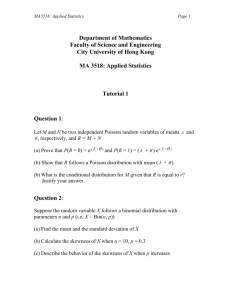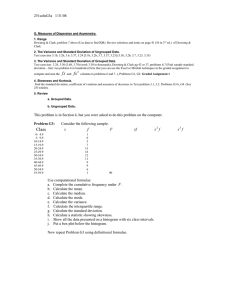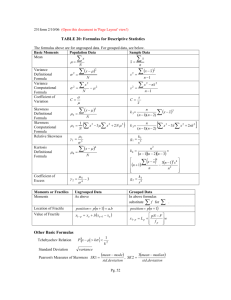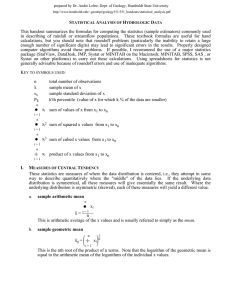251y9852 10/05/98 ECO251 QBA1 Name __________________
advertisement
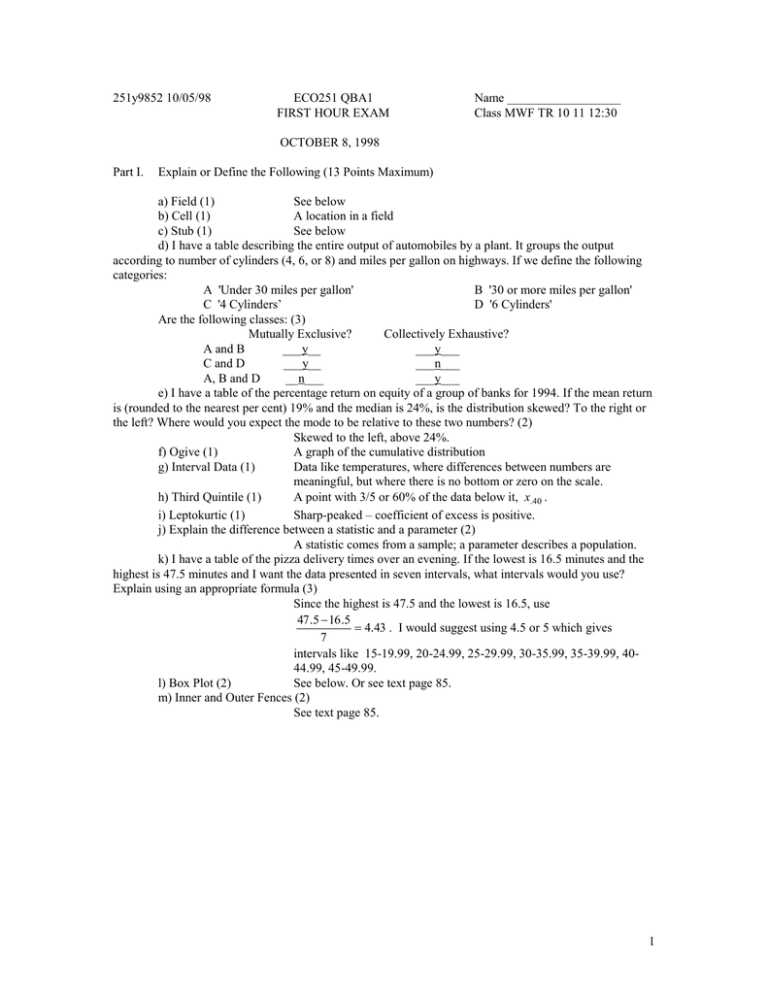
251y9852 10/05/98 ECO251 QBA1 FIRST HOUR EXAM Name __________________ Class MWF TR 10 11 12:30 OCTOBER 8, 1998 Part I. Explain or Define the Following (13 Points Maximum) a) Field (1) See below b) Cell (1) A location in a field c) Stub (1) See below d) I have a table describing the entire output of automobiles by a plant. It groups the output according to number of cylinders (4, 6, or 8) and miles per gallon on highways. If we define the following categories: A 'Under 30 miles per gallon' B '30 or more miles per gallon' C '4 Cylinders’ D '6 Cylinders' Are the following classes: (3) Mutually Exclusive? Collectively Exhaustive? A and B ___y__ ___y___ C and D ___y__ ___n___ A, B and D __n___ ___y___ e) I have a table of the percentage return on equity of a group of banks for 1994. If the mean return is (rounded to the nearest per cent) 19% and the median is 24%, is the distribution skewed? To the right or the left? Where would you expect the mode to be relative to these two numbers? (2) Skewed to the left, above 24%. f) Ogive (1) A graph of the cumulative distribution g) Interval Data (1) Data like temperatures, where differences between numbers are meaningful, but where there is no bottom or zero on the scale. h) Third Quintile (1) A point with 3/5 or 60% of the data below it, x.40 . i) Leptokurtic (1) Sharp-peaked – coefficient of excess is positive. j) Explain the difference between a statistic and a parameter (2) A statistic comes from a sample; a parameter describes a population. k) I have a table of the pizza delivery times over an evening. If the lowest is 16.5 minutes and the highest is 47.5 minutes and I want the data presented in seven intervals, what intervals would you use? Explain using an appropriate formula (3) Since the highest is 47.5 and the lowest is 16.5, use 47 .5 16 .5 4.43 . I would suggest using 4.5 or 5 which gives 7 intervals like 15-19.99, 20-24.99, 25-29.99, 30-35.99, 35-39.99, 4044.99, 45-49.99. l) Box Plot (2) See below. Or see text page 85. m) Inner and Outer Fences (2) See text page 85. 1 251y9852 10/05/98 Part II. Give Formulas for the Following (12 Points maximum): a) Population Variance (Definitional formula for ungrouped data) (2) 1 1 1 b) Harmonic Mean (1) xh n x c) Population Mean (Grouped data) (1) 2 x 2 N fx N d) Sample Standard Deviation (Use words!) (1) The square root of the sample variance. e) Coefficient of Variation (For a sample)(1) C f) Sample Skewness k 3 k3 (1) s x n n x x 3 (n 1)( n 2) (n 1)( n 2) x 3x x 2 2nx 3 3 g) Sample Variance (Grouped Data - Computational Formula (2) s 2 h) Kurtosis (Population - Ungrouped) (2) 4 fx x 2 nx 2 n 1 4 N 3mean mode i) Pearson's Measure of Skewness (2) SK std. deviation j) Compute the Geometric Mean of the numbers 3, 5, 7 and 8 (2) 1 x g x1 x2 x3 xn n n x or ln x g 1 ln( x) n 1 x g 3 5 7 8 4 4 840 5.38356 k) Explain Chebyschef's Inequality (A formula or diagram may be used) (3) P x k 1 k2 2 251y9852 10/05/98 Part III. Do the Following Problems (25 Points) To control costs, a company takes a sample of salespersons’ expenditures in entertaining clients. Results are as follows: 155 130 107 143 123 137 n 6 , x 795 , x 2 x x 2 x2 x Compute the Following: a) Mean Expenditures (1) b) The Median (1) c) The Standard Deviation (3) d) The 80th Percentile (2) x 155 24025 130 16900 107 11449 143 20449 123 15129 137 18769 795 106721 2 index x in order 1 107 2 123 3 130 4 137 5 143 6 155 106721 , x x 0.00 , x x 2 1383.5 . x 795 as some of you seem to have fooled yourselves into believing. Nor is equal to x x 795 132 .5 . If you had tried these in any of the homework problems, is not 2 2 2 2 you would have found that they didn’t work. a) x x 795 132.5 n 6 b) position pn 1 a.b .57 3.5 x1 p x a .b ( x a 1 x a ) so x1.5 x.5 x3 .5( x4 x3 ) 130 137 133.5 2 x x 2 1383.5 x 2 nx 2 106721 6132 .52 2 2 c) s 276 .7 s 276.7 n 1 5 n 1 5 s 276.7 16.6343 d) The 80th percentile has 80% below it. position pn 1 a.b .87 5.6 x1 p x a .b ( x a 1 x a ) so x1.8 x.2 x5 .6( x6 x5 ) 143 .6(155 143) 150.2 130 .5(137 130) 3 251y9852 10/05/98 2. An automobile is taken from each of 50 production runs and tested for miles per gallon. A summary of the results is shown below: Mileage Frequency 29.80-30.39 30.40-30.99 31.00-31.59 31.60-32.19 32.20-32.79 32.80-33.39 n f 50, Midpoint F f 5 8 12 13 9 3 50 5 13 25 38 47 50 fx x 30.1 30.7 31.3 31.9 32.5 33.1 1578.2, fx3 fx 2 fx 150.5 4530.05 245.6 7539.92 375.6 11756.28 414.7 13228.93 292.5 9506.25 99.3 3286.83 1578.2 49848.26 fx f x x 0.0000, f x x 2 2 136354.505 231475.544 367971.564 422002.867 308953.125 108794.093 1575551.698 49848.26, and 33.9552, and fx 3 f x x 3 1575551.698. 2.32443. As usual half of the people who tried to compute these last three sums got them wrong. See the example in the outline. a. Calculate the Cumulative Frequency (1) (See above) b. Calculate the Mean (1) x fx 1578.2 31.564 n 50 c. Calculate the Median (2) position pn 1 .551 25.5 . This is above 25 and below 38, so pN F the interval is 31.60 to 32.19. x1 p L p w so f p .550 25 x1.5 x.5 31.60 0.6 31.60 13 d. Calculate the Mode (1) The mode is the midpoint of the largest group. Since 13 is the largest frequency, the modal group is 31.60 to 32.19 and the mode is 31.9. e. Calculate the Variance (3) s f x x 2 s2 n 1 2 fx 2 nx 2 n 1 49848 .26 50 31 .576 2 0.6930 49 33.9552 0.6929 49 f. Calculate the Standard Deviation (2) s 0.693 0.8325 4 251y9852 10/05/98 position pn 1 .2551 12.75 . This is pN F Lp w gives us f p g. Calculate the Interquartile Range (3) First Quartile: just below 13, so the group is 30.40 to 30.99. x1 p .2550 5 Q1 x1.25 x.75 30.40 0.6 30.962 8 Third Quartile: position pn 1 .7551 38.25 . This is just above 38, so the group is 32.20 to .7550 38 32.79. x1.75 x.25 32.20 0.6 32.167 . Since this produces a number below 9 32, I have directed you to use 31.60 to 32.19 – this is the only time that I have seen this formula break down. .7550 25 Q3 x1.75 x.25 31.60 0.6 32.177. 13 IQR Q3 Q1 32.177 30.962 1.215 . h. Calculate a Statistic showing Skewness and interpret it (3) k 3 n (n 1)( n 2) fx 3 3x fx 2 2nx 3 50 3 157551.698 331.57649848.26 25031.564 0.0490 . 4948 n x x 3 50 2.3244 0.0494 (n 1)( n 2) 4948 k 0.0494 or g1 33 0.085 s 0.83253 3mean mod e 331.564 31.9 1.211. or Pearson's Measure of Skewness SK std.deviation 0.8325 or k 3 Because of the negative sign, all of these imply skewness to the left. i. Make a Frequency Polygon of the Data (Neatness Counts!)(2) 5

